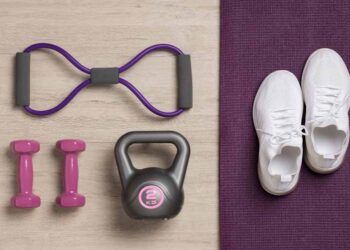Are you looking to enhance your lower-body strength, improve balance, and prevent injuries? The key lies in developing strong hamstrings. Often overlooked, the hamstrings play a crucial role in our overall leg strength and athletic performance. But how can you effectively build strength and flexibility in your hamstrings?
In this article, we will explore a range of exercises that target the hamstrings, helping you build the power you need for a stronger, more resilient body. Whether you are an athlete or simply want to improve your fitness level, these exercises can benefit anyone seeking to enhance their hamstring strength and flexibility.
Key Takeaways:
- Developing strong hamstrings is crucial for lower-body strength, balance, and injury prevention.
- Strong hamstrings contribute to overall leg strength and enhance athletic performance.
- Building strong hamstrings can improve posture, reduce lower back pain, and enhance mobility.
- The top 5 hamstring exercises everyone should try include Romanian deadlifts, Bulgarian split squats, prone leg curls, kettlebell swings, and good mornings.
- Preventing hamstring injuries involves proper stretching, maintaining strong glutes, and avoiding prolonged periods of sitting.
The Benefits of Building Strong Hamstrings
Building strong hamstrings offers several benefits. Strong hamstrings contribute to overall leg strength, enhance athletic performance, and improve daily activities. They act as crucial stabilizers, reducing the risk of strains or injuries. Well-developed hamstring muscles help stabilize the knee joint, reducing the risk of knee injuries. Strong hamstrings also improve speed, efficiency, stability, and balance during various physical activities. Additionally, developing your hamstrings can improve flexibility, posture, and reduce lower back pain.
When it comes to leg strength, strong hamstrings play a vital role. These muscles are responsible for flexing the knee joint and extending the hip joint, allowing movements like running, jumping, and squatting. By focusing on building strong hamstrings, you enhance your ability to perform these movements with power and control, leading to improved athletic performance.
Strong hamstrings also contribute to better daily activities. They provide stability and support during movements like walking, climbing stairs, and bending down. Having well-developed hamstrings ensures that you can perform these daily tasks with ease and without the risk of injury.
One of the key benefits of building strong hamstrings is their role as stabilizers. The hamstrings work in conjunction with other leg muscles to stabilize the knee joint during movements. By strengthening the hamstrings, you reduce the risk of strains or injuries, especially in activities that put stress on the knees, such as running and jumping.
Additionally, strong hamstrings improve speed, efficiency, stability, and balance during various physical activities. Whether you’re a competitive athlete or someone who enjoys recreational sports, having strong hamstrings can give you a competitive edge. These muscles help generate power and support quick movements, leading to improved performance.
Moreover, developing your hamstrings can improve flexibility and posture. Tight or weak hamstrings can lead to poor posture and limit your range of motion. By incorporating hamstring exercises into your routine, you can increase your flexibility and maintain proper alignment of the spine, contributing to better posture and reduced lower back pain.
In conclusion, building strong hamstrings offers multiple benefits, including overall leg strength, enhanced athletic performance, and improved daily activities. Strong hamstrings serve as crucial stabilizers, reducing the risk of strains or injuries, particularly in the knee joint. They also improve speed, efficiency, stability, and balance during physical activities while promoting flexibility and supporting proper posture. By prioritizing hamstring exercises, you can achieve a stronger and more resilient body.
The Top 5 Hamstring Exercises Everyone Should Try
Incorporating the following hamstring exercises into your routine can help build strength and flexibility in your hamstrings:
- Romanian deadlifts: Stand with feet hip-width apart, engage the core, hinge at the hips, and lower the barbell down the length of your legs. Stand up straight while engaging your glutes and hamstrings.
- Bulgarian split squats: Stand facing away from a bench, place one foot behind you on the bench, bend your front knee until your thigh is parallel to the ground, then push up through your front heel to return to the starting position. Repeat the reps with the other leg.
- Prone leg curls: Lie face down on a leg curl machine, flex your knees to curl the lever toward your glutes, then slowly extend your legs back to the starting position.
- Kettlebell swings: Stand with feet shoulder-width apart, grab a kettlebell with both hands, swing it between your legs while keeping your hips back, and explosively thrust your hips forward to swing the kettlebell up to chest height.
- Good mornings: Stand with feet shoulder-width apart, hinge at your hips, and bend forward while keeping your back straight. Push your hips forward to return to an upright position.
By regularly performing these top 5 hamstring exercises, you can target and strengthen your hamstrings, leading to improved strength and flexibility in your lower body.

Common Hamstring Injuries and How to Prevent Them
Hamstring injuries are common among casual exercisers and athletes. These injuries occur when any of the three hamstring muscles are strained or pulled, resulting in discomfort and limited mobility. While hamstring injuries can be painful and frustrating, they can often be prevented with proper care and precautionary measures. Understanding the causes and taking preventative actions can help reduce the risk of hamstring injuries.
Sports that involve quick stops and starts, such as soccer, tennis, basketball, running, and dancing, are particularly prone to hamstring injuries. These activities require sudden bursts of speed or changes in direction, placing excessive stress on the hamstring muscles. Poor conditioning, inadequate warm-up or cool-down routines, and muscle imbalances can contribute to the likelihood of injury.
To prevent hamstring injuries, it is crucial to prioritize stretching both before and after workouts. Dynamic stretches, such as high knees, leg swings, and walking lunges, are effective in preparing the muscles for activity and increasing flexibility. Incorporating standing and supine hamstring stretches into your routine can also help maintain and improve hamstring flexibility.
Sitting stretches, such as the hamstring lengthener, can be beneficial for individuals who spend long periods in a seated position. This stretch involves sitting on the edge of a chair or bench, extending one leg straight in front while leaning forward and reaching towards the toes. Performing this stretch regularly can help prevent muscle imbalances and reduce the risk of injury.
Besides stretching, maintaining strong glutes is essential for hamstring injury prevention. The gluteus maximus and medius muscles play a crucial role in stabilizing the hip during movement, which can alleviate strain on the hamstrings. Incorporating exercises that target the glutes, such as squats, lunges, and hip thrusts, into your fitness routine can help ensure overall lower body strength and reduce the risk of hamstring injuries.
Additionally, taking breaks from prolonged sitting and engaging in regular movement can assist in keeping the hamstrings and other muscles in the posterior chain healthy and less susceptible to injury. Avoiding prolonged positions that place excessive load on the hamstrings, such as sitting with straight legs or keeping the legs crossed for extended periods, can help prevent strain on the muscles.
By adopting a comprehensive approach that includes appropriate stretching, strengthening exercises, and lifestyle modifications, you can minimize the risk of common hamstring injuries. Prioritizing injury prevention and employing proper techniques will help keep your hamstrings healthy, allowing you to enjoy your favorite activities without the worry of injury.
Remember, preventing hamstring injuries is crucial for maintaining an active lifestyle. Make sure to consult a healthcare professional or physical therapist for guidance on the most suitable exercises and stretches for your specific needs and fitness level.
Conclusion
Building strong and flexible hamstrings is essential for lower-body strength, balance, and injury prevention. By incorporating a variety of hamstring exercises into your routine, you can achieve these goals and enhance your overall leg strength. Strong hamstrings not only contribute to better athletic performance but also help reduce the risk of strains and injuries.
In addition to strengthening your lower body, developing your hamstrings can improve your posture and mobility, while reducing lower back pain. Regularly performing exercises like Romanian deadlifts, Bulgarian split squats, prone leg curls, kettlebell swings, and good mornings can effectively target and strengthen your hamstrings.
However, it’s important to not only focus on exercise but also take steps to prevent hamstring injuries. Stretching before and after workouts, incorporating standing and supine hamstring stretches, and maintaining strong glutes are essential for injury prevention. Additionally, avoiding prolonged periods of sitting can help keep your hamstrings and other posterior chain muscles in good condition.
By prioritizing both strengthening and preventing hamstring injuries, you can develop a stronger, more resilient body. Remember to consult with a fitness professional and listen to your body’s limitations while incorporating these exercises into your routine, and always consult with a healthcare provider if you experience any pain or discomfort.













